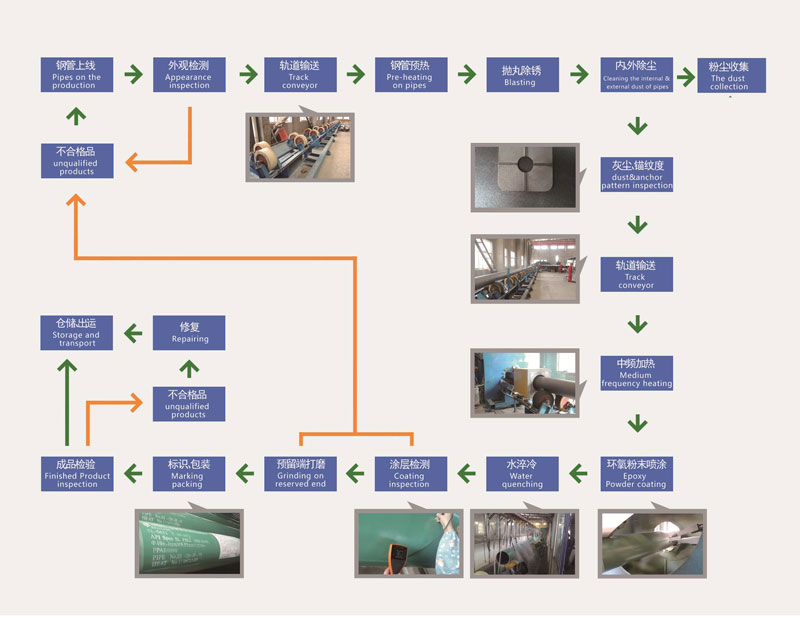ISO 21809-2 Fusion Bonded Epoxy (FBE) Coated Line Pipe
- Applied Steel Service Pipe: API 5L/ISO 3183 Gr.B-X100, ASTM A53/A106 Gr.B, ASTM A333 Gr.1/3/6, ASTM A671/A672/A691
ISO 21809-2 Fusion Bonded Epoxy (FBE) Coated Line Pipe
Our ISO 21809-2 fusion bonded epoxy (FBE) coated line pipe is designed to meet the stringent requirements of the international standard ISO 21809-2 for coatings for pipes and fittings for pipelines in petroleum and natural gas industries. The FBE coating is applied through fusion bonding, where a thin layer of epoxy resin is applied to the pipe surface and then cured at high temperatures, resulting in a strong, durable, and corrosion-resistant coating. The coating provides excellent resistance to acidic and alkaline environments and protection against mechanical damage and abrasion. Our ISO 21809-2 FBE coated line pipe is widely used in various applications, including oil and gas transportation pipelines, offshore platforms, and land-based infrastructure projects. With its excellent performance characteristics, our FBE coated line pipe ensures reliable operation, reduced maintenance costs, and extended lifespan of the pipeline system.
Specifications
| Standard | ISO 21809-2 Fusion Bonded Epoxy (FBE) Coated Line Pipe |
| Applied Steel Service Pipe | API 5L/ISO 3183 Gr.B-X100, ASTM A53/A106 Gr.B, ASTM A333 Gr.1/3/6, ASTM A671/A672/A691 |
| Processing ability | OD:38mm-1620mm;WT:2mm-30mm |
| Length | 6-18m |
| Surface Preparation | ISO 8501-1/SIS 055900/DIN 55928 Sa 2.5/NACE No.2/SPCC SP10 (Near White Metal Finish) |
| Base Material | Epoxy resin |
| Application Method | Electrostatic powder coating |
| Curing | Thermal curing |
| Packing | 1. Both pipe ends are beveled to 30°+5°/-0° according to ASME B16.25. 2. For large-diameter pipes (OD≥NPS 8″), each pipe is equipped with three anti-collision ropes (3 locations) and two slings, with plastic covers at the ends of the pipes or reusable metal bevel protectors (with sealing cloth), loosely packed. 3. For small-diameter pipes (OD≤NPS 6″), each pipe is equipped with three anti-collision ropes (3 locations), plastic covers at the ends of the pipes, and two slings per bundle (the whole bundle can be wrapped in a woven bag according to the coating type or customer requirements) and tied with plastic strips (woven bags are placed underneath to protect the coating from scratches) |
| Technique | External anti-corrosion coating on Seamless/LSAW/SSAW/JCOE/UOE/RBE Line Pipe |
| Service condition | Designed Working Temperature Range: -40℃ to +85℃ |
| Place of Origin | Made in China |
| MOQ | Depends on order quantity |
| Transportation | Railway, Sea |
Coating Thickness
| Coating Thickness Range | Typical Value |
| Minimum Thickness | 300 microns |
| Typical Thickness | 300 – 500 microns |
| Maximum Thickness | Depends on specific application requirements |
Coating Performance
| Performance Characteristic | Unit | Value/Requirement |
| Adhesion | MPa | ≥ 10 |
| Impact Resistance | J | ≥ 5 |
| Cathodic Disbondment | mm radius | ≤ 5 (at 23°C for 28 days, -1.5V) |
| Water Absorption | % | ≤ 0.5 |
| Flexibility | ° per diameter | No cracking at an angle of 2.5° per pipe diameter length |
| Hardness | Shore D | ≥ 80 |
| Dielectric Strength | kV/mm | ≥ 40 |
| Thermal Aging Resistance | % retention | ≥ 85 (after 100 days at 100°C) |
| Salt Spray Resistance | Hours | ≥ 2000 |
| Resistance to Soil Stress | % elongation | ≥ 2.5 |
FBE coating production process

Applications of ISO 21809-2 FBE Coated Line Pipe
ISO 21809-2 specifies requirements for Fusion Bonded Epoxy (FBE) coated steel line pipes, which are widely used for their excellent corrosion resistance and mechanical protection.
Oil and Gas Industry:
Transmission Pipelines: Transporting crude oil, natural gas, and refined petroleum products over long distances from production sites to refineries and distribution centers.
Flowlines: Pipelines that connect the wellhead to processing facilities or main pipelines.
Gathering Lines: Collect oil and gas from multiple wells and transport them to processing plants.
Water Supply Systems:
Potable Water Pipelines: These pipes distribute drinking water from treatment plants to consumers, ensuring water quality is maintained by preventing corrosion.
Irrigation Pipelines: Transporting water for agricultural purposes, where protection against soil chemicals is necessary.
Industrial Applications:
Chemical and Petrochemical Plants: This is the conveyance of chemicals, petrochemicals, and other industrial fluids where corrosion resistance is critical.
Slurry Pipelines: Transport of abrasive materials like mining slurries, offering protection against abrasion and corrosion.
Infrastructure Projects:
Urban and Rural Infrastructure: Pipes used in municipal water supply, sewage systems, and other utilities.
Power Plants: Pipelines for cooling water and other utilities, where durability and reliability are essential.
Marine and Coastal Environments:
Harbor and Dock Installations: Pipelines exposed to seawater and harsh coastal conditions, protecting against saltwater corrosion.
Desalination Plants: Conveyance of seawater to and from desalination facilities, offering high resistance to saline environments.
Storage Facilities:
Tank Farms: Pipelines connecting storage tanks for various liquids and gases, ensuring long-term integrity and safety.
District Heating Systems:
Hot Water Pipelines: Transporting hot water for district heating, requiring coatings that can withstand high temperatures and prevent corrosion.
Mining Industry:
Tailings Pipelines: Transporting mining waste, requiring strong abrasion and corrosion resistance.
Leaching Lines: Pipelines used in hydrometallurgical processes where aggressive chemicals are used.




